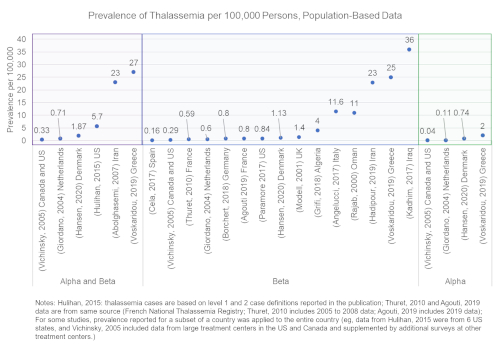
Contributions
Abstract: EP1318
Type: E-Poster Presentation
Session title: Thalassemias
Background
Alpha and beta-thalassemia are characterized by imbalanced globin chain production, resulting in ineffective erythropoiesis and hemolytic anemia. Patients with thalassemia intermedia or major may experience serious complications including iron overload, osteoporosis, thrombosis and increased mortality. While thalassemias are common in areas historically endemic to malaria, the global epidemiology is changing due to factors such as population screening, improved survival rates, and migration. Comprehensive understanding of the global prevalence particularly with region- and subtype-specific estimates is limited.
Aims
To determine the global prevalence of alpha- and beta-thalassemia (excluding minor/trait types), and to identify critical evidence gaps.
Methods
A systematic literature review (SLR) was conducted. Excerpta Medica database (Embase), PubMed (via MEDLINE), and the Cochrane Library (Database of Systematic Reviews) were searched to identify real-world observational studies published from Jan. 1, 2000 to Jun. 15, 2020 reporting on the incidence and/or prevalence of thalassemia. Dual independent screening was performed with disagreements resolved by a third researcher. Data extraction was performed by a single reviewer with full validation by a second reviewer. Prevalence per 100,000 people was estimated based on dates of data collection from respective included publications. Results were also extrapolated to estimate the number of patients with thalassemia in European countries and the United States (US).
Results
Of 1,900 records screened, 58 publications met the protocol-defined selection criteria for inclusion in the SLR.
Population-based prevalence data were reported in 17 studies (see Figure) from North America, Europe, the Middle East, and North Africa. In the US, the estimated population-based prevalence of alpha- and beta-thalassemia combined was 5.7/100,000. Among other countries with population-based studies, prevalence data were predominantly reported for beta-thalassemia only. In Europe, the estimated beta-thalassemia prevalence (9 studies) ranged from 0.16/100,000 in Spain to 25/100,000 in Greece; alpha-thalassemia prevalence (3 studies) was low, ranging from 0.11/100,000 in the Netherlands to 2/100,000 in Greece. In a single population-based analysis from North Africa, the prevalence of beta-thalassemia was 4/100,000 in Algeria, and across the Middle East (3 studies), the prevalence of beta-thalassemia ranged from 11/100,000 in Oman to 36/100,000 in Iraq.
Thalassemia prevalence data from Africa, Asia, and South America were mainly limited to specific sites or study samples that may not be generalizable to their respective countries. Further, the prevalence results ranged widely, indicating potential selection bias in these non-population-based studies.
Key evidence gaps in the published literature included incomplete reporting of thalassemia subtypes, lack of diagnosis confirmation, and a paucity of recent, population-based analyses, including from countries with thalassemia registries.

Conclusion
Based on available published data, the estimated prevalence of thalassemia (excluding minor/trait types) varied globally, with highest prevalence in Greece and the Middle East, and lowest prevalence in the Netherlands, Spain, France and Germany. There is limited prevalence data in non-Western countries, and in alpha-thalassemia in general. Additional studies, including global and country-specific thalassemia registries, are needed to better understand the current prevalence of this condition.
Keyword(s): Epidemiology, Prevalence, Systematic review, Thalassemia
Abstract: EP1318
Type: E-Poster Presentation
Session title: Thalassemias
Background
Alpha and beta-thalassemia are characterized by imbalanced globin chain production, resulting in ineffective erythropoiesis and hemolytic anemia. Patients with thalassemia intermedia or major may experience serious complications including iron overload, osteoporosis, thrombosis and increased mortality. While thalassemias are common in areas historically endemic to malaria, the global epidemiology is changing due to factors such as population screening, improved survival rates, and migration. Comprehensive understanding of the global prevalence particularly with region- and subtype-specific estimates is limited.
Aims
To determine the global prevalence of alpha- and beta-thalassemia (excluding minor/trait types), and to identify critical evidence gaps.
Methods
A systematic literature review (SLR) was conducted. Excerpta Medica database (Embase), PubMed (via MEDLINE), and the Cochrane Library (Database of Systematic Reviews) were searched to identify real-world observational studies published from Jan. 1, 2000 to Jun. 15, 2020 reporting on the incidence and/or prevalence of thalassemia. Dual independent screening was performed with disagreements resolved by a third researcher. Data extraction was performed by a single reviewer with full validation by a second reviewer. Prevalence per 100,000 people was estimated based on dates of data collection from respective included publications. Results were also extrapolated to estimate the number of patients with thalassemia in European countries and the United States (US).
Results
Of 1,900 records screened, 58 publications met the protocol-defined selection criteria for inclusion in the SLR.
Population-based prevalence data were reported in 17 studies (see Figure) from North America, Europe, the Middle East, and North Africa. In the US, the estimated population-based prevalence of alpha- and beta-thalassemia combined was 5.7/100,000. Among other countries with population-based studies, prevalence data were predominantly reported for beta-thalassemia only. In Europe, the estimated beta-thalassemia prevalence (9 studies) ranged from 0.16/100,000 in Spain to 25/100,000 in Greece; alpha-thalassemia prevalence (3 studies) was low, ranging from 0.11/100,000 in the Netherlands to 2/100,000 in Greece. In a single population-based analysis from North Africa, the prevalence of beta-thalassemia was 4/100,000 in Algeria, and across the Middle East (3 studies), the prevalence of beta-thalassemia ranged from 11/100,000 in Oman to 36/100,000 in Iraq.
Thalassemia prevalence data from Africa, Asia, and South America were mainly limited to specific sites or study samples that may not be generalizable to their respective countries. Further, the prevalence results ranged widely, indicating potential selection bias in these non-population-based studies.
Key evidence gaps in the published literature included incomplete reporting of thalassemia subtypes, lack of diagnosis confirmation, and a paucity of recent, population-based analyses, including from countries with thalassemia registries.

Conclusion
Based on available published data, the estimated prevalence of thalassemia (excluding minor/trait types) varied globally, with highest prevalence in Greece and the Middle East, and lowest prevalence in the Netherlands, Spain, France and Germany. There is limited prevalence data in non-Western countries, and in alpha-thalassemia in general. Additional studies, including global and country-specific thalassemia registries, are needed to better understand the current prevalence of this condition.
Keyword(s): Epidemiology, Prevalence, Systematic review, Thalassemia


